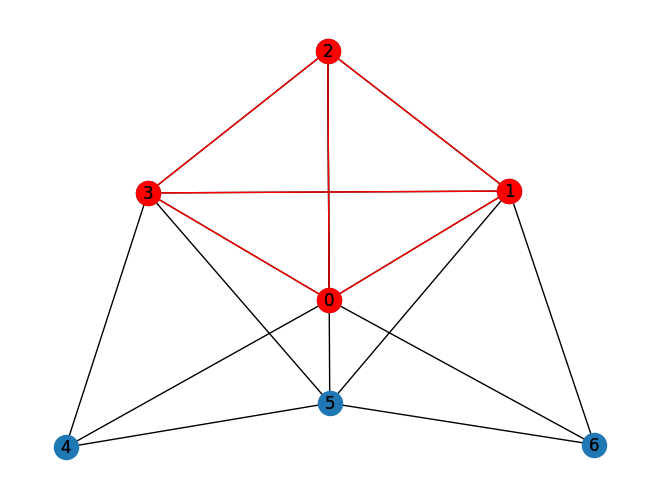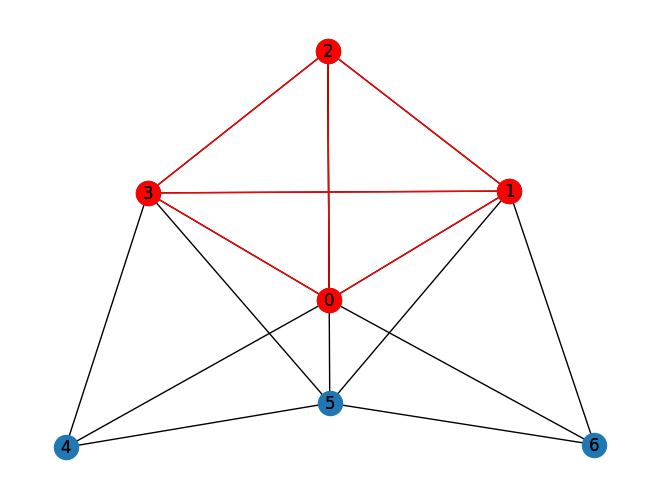Max Clique Problem
Background
The problem is in graph theory. A clique is a subset of vertices in a graph such each pair of them is adjacent to each other.
The max clique problem is given a graph \(G = (V,E)\), find the maximal clique in the graph. It is known to be in the NP-hard complexity class.
Solving the problem with classiq
Define the optimization problem
We encode each node
import networkx as nx
import numpy as np
import pyomo.environ as pyo
def define_max_clique_model(graph):
model = pyo.ConcreteModel()
# each x_i states if node i belongs to the cliques
model.x = pyo.Var(graph.nodes, domain=pyo.Binary)
x_variables = np.array(list(model.x.values()))
# define the complement adjacency matrix as the matrix where 1 exists for each non-existing edge
adjacency_matrix = nx.convert_matrix.to_numpy_array(graph, nonedge=0)
complement_adjacency_matrix = (
1
- nx.convert_matrix.to_numpy_array(graph, nonedge=0)
- np.identity(len(model.x))
)
# constraint that 2 nodes without edge in the graph cannot be chosen together
model.clique_constraint = pyo.Constraint(
expr=x_variables @ complement_adjacency_matrix @ x_variables == 0
)
# maximize the number of nodes in the chosen clique
model.value = pyo.Objective(expr=sum(x_variables), sense=pyo.maximize)
return model
Initialize the model with parameters
graph = nx.erdos_renyi_graph(7, 0.6, seed=79)
nx.draw_kamada_kawai(graph, with_labels=True)
max_clique_model = define_max_clique_model(graph)

Setting Up the Classiq Problem Instance
In order to solve the Pyomo model defined above, we use the CombinatorialProblem python class. Under the hood it translates the Pyomo model to a quantum model of the QAOA algorithm [1], with cost hamiltonian translated from the Pyomo model. We can choose the number of layers for the QAOA ansatz using the argument num_layers.
from classiq import *
from classiq.applications.combinatorial_optimization import CombinatorialProblem
combi = CombinatorialProblem(pyo_model=max_clique_model, num_layers=3)
qmod = combi.get_model()
write_qmod(qmod, "max_clique")
Synthesizing the QAOA Circuit and Solving the Problem
We can now synthesize and view the QAOA circuit (ansatz) used to solve the optimization problem:
qprog = combi.get_qprog()
show(qprog)
Opening: https://nightly.platform.classiq.io/circuit/12b0d353-e44e-4992-bcb8-deb3a88a482b?version=0.62.0.dev7
We also set the quantum backend we want to execute on:
from classiq.execution import *
execution_preferences = ExecutionPreferences(
backend_preferences=ClassiqBackendPreferences(backend_name="simulator"),
)
We now solve the problem by calling the optimize method of the CombinatorialProblem object. For the classical optimization part of the QAOA algorithm we define the maximum number of classical iterations (maxiter) and the \(\alpha\)-parameter (quantile) for running CVaR-QAOA, an improved variation of the QAOA algorithm [2]:
optimized_params = combi.optimize(execution_preferences, maxiter=50, quantile=0.7)
Optimization Progress: 51it [02:27, 2.88s/it]
import matplotlib.pyplot as plt
plt.plot(combi.cost_trace)
plt.xlabel("Iterations")
plt.ylabel("Cost")
plt.title("Cost convergence")
Text(0.5, 1.0, 'Cost convergence')

Optimization Results
We can also examine the statistics of the algorithm. The optimization is always defined as a minimzation problem, so the positive maximization objective was tranlated to a negative minimization one by the Pyomo to qmod translator.
In order to get samples with the optimized parameters, we call the sample method:
optimization_result = combi.sample(combi.optimized_params)
optimization_result.sort_values(by="cost").head(5)
| solution | probability | cost | |
|---|---|---|---|
| 93 | {'x': [0, 1, 1, 1, 0, 1, 0]} | 0.000488 | -4.0 |
| 86 | {'x': [1, 1, 1, 1, 0, 0, 0]} | 0.000488 | -4.0 |
| 50 | {'x': [0, 1, 1, 0, 0, 1, 0]} | 0.003418 | -3.0 |
| 41 | {'x': [1, 1, 0, 1, 0, 0, 0]} | 0.004883 | -3.0 |
| 44 | {'x': [1, 0, 1, 1, 0, 0, 0]} | 0.004395 | -3.0 |
We will also want to compare the optimized results to uniformly sampled results:
uniform_result = combi.sample_uniform()
And compare the histograms:
optimization_result["cost"].plot(
kind="hist",
bins=40,
edgecolor="black",
weights=optimization_result["probability"],
alpha=0.6,
label="optimized",
)
uniform_result["cost"].plot(
kind="hist",
bins=40,
edgecolor="black",
weights=uniform_result["probability"],
alpha=0.6,
label="uniform",
)
plt.legend()
plt.ylabel("Probability", fontsize=16)
plt.xlabel("cost", fontsize=16)
plt.tick_params(axis="both", labelsize=14)

Let us plot the solution:
best_solution = optimization_result.solution[optimization_result.cost.idxmin()]
best_solution
{'x': [1, 1, 1, 1, 0, 0, 0]}
solution_nodes = [v for v in graph.nodes if best_solution["x"][v]]
solution_edges = [
(u, v) for u, v in graph.edges if u in solution_nodes and v in solution_nodes
]
nx.draw_kamada_kawai(graph, with_labels=True)
nx.draw_kamada_kawai(
graph,
with_labels=True,
nodelist=solution_nodes,
edgelist=solution_edges,
node_color="r",
edge_color="r",
)

Comparison to a classical solver
Lastly, we can compare to the classical solution of the problem:
from pyomo.opt import SolverFactory
solver = SolverFactory("couenne")
solver.solve(max_clique_model)
classical_solution = [
int(pyo.value(max_clique_model.x[i])) for i in range(len(max_clique_model.x))
]
print("Classical solution:", classical_solution)
Classical solution: [1, 1, 1, 1, 0, 0, 0]
solution = [int(pyo.value(max_clique_model.x[i])) for i in graph.nodes]
solution_nodes = [v for v in graph.nodes if solution[v]]
solution_edges = [
(u, v) for u, v in graph.edges if u in solution_nodes and v in solution_nodes
]
nx.draw_kamada_kawai(graph, with_labels=True)
nx.draw_kamada_kawai(
graph,
with_labels=True,
nodelist=solution_nodes,
edgelist=solution_edges,
node_color="r",
edge_color="r",
)

References
[1]: Farhi, Edward, Jeffrey Goldstone, and Sam Gutmann. "A quantum approximate optimization algorithm." arXiv preprint arXiv:1411.4028 (2014).
[2]: Barkoutsos, Panagiotis Kl, et al. "Improving variational quantum optimization using CVaR." Quantum 4 (2020): 256.